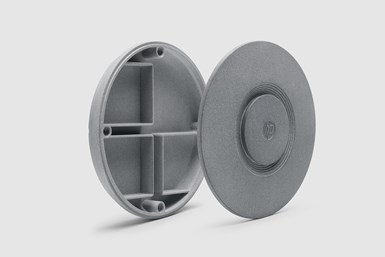HP’s 3D HR PA 12 S Polymer Material Creates Smooth Finishes for Cost-Efficient Parts Production
The material can be used to create smooth surface finishes, which enables an optimized production process that streamlines postprocessing steps, thereby saving time and further reducing costs for producing complex smooth parts.
HP’s 3D HR PA 12 S polymer material, enabled by Arkema, is designed to provide a better surface finish with a lower cost per part. Customers such as Accel Digital Solutions, Decathlon, Erpro Group and Materialise are utilizing the material to develop production 3D parts across industries using HP’s industrial solutions, software and materials.
Developed with Arkema, HP says the new PA 12 S material sets a new standard for surface aesthetics, while reducing costs for customers using HP’s Jet Fusion 5200 Series 3D printing solutions. The reach of this material will soon expand, as it is set to become available for the Jet Fusion 5600 Series later this spring, thereby broadening its application across HP's suite of polymer 3D printing solutions.
“From design to parts production and postprocessing, HP is committed to delivering a broad range of innovative materials and programs for more sustainable production,” says Francois Minec, HP global head of 3D polymers.
Users can optimize production costs and efficiency by manufacturing with PA 12 S material to reduce variable costs per part and significantly lowering the total cost of ownership. According to the company, using this material in conjunction with HP Multi Jet Fusion technology, offers an optimized production process that streamlines postprocessing steps, saving time and further reducing costs. These advancements enable manufacturers to produce parts more efficiently while maintaining high quality and sustainability standards.
HP says the material demonstrates a commitment to sustainable production. It is said the PA 12 S material has the highest reusability ratio versus other PA 12 materials in the market, with an up to 85% reusability ratio, thus minimizing waste.
The material is being used by customers such as Accel Digital Solutions, Decathlon, Erpro Group and Materialise for aesthetic parts with enhanced surface finishes and lower production costs.
Accel Digital Solutions, an additive manufacturing (AM) startup, has embraced the PA 12 S material. Brandon Teets, the founder, cites HP’s Multi Jet Fusion technology’s cutting-edge capabilities. “HP’s Multi Jet Fusion equipment delivers unmatched precision, speed and quality for both prototyping and production of parts and finished goods. This technology enables us to provide substantial value through time and cost savings, benefiting industries such as automotive, health care, sports and more,” Teets says. “After receiving test samples of the new HR PA 12 S material, we found the print quality and surface finish were markedly better.”
Grégoire Mercusor, additive manufacturing materials strategy leader at French retail company Decathlon, highlighted the material's impact on reducing part roughness, likening its effect to hours of tribofinishing on current materials. “The high refresh rate of up to 85% and the attractive price point of PA 12 S are poised to unlock new project opportunities,” Mercusor says.
Quentin Bertucchi, applications engineer at Erpro Group, is also pleased with PA 12 S. “This PA 12 S material offers an unprecedented combination of surface finish and productivity, giving us new production opportunities when it comes to aesthetic parts,” Bertucchi says. “The smooth surface is an ideal base for further postprocessing steps, sublimating the final result, and lowering the cost of providing complex smooth parts.”
Materialise worked with HP as a beta customer for PA 12 S. “[This] is an important element in our strategy to make additive manufacturing more accessible through an extended industrial grade materials offering,” says Pieter Vos, Materialise marketing and product director. “PA 12 S has proven its processability, delivering consistent parts with a great surface quality. We look forward to exploring application opportunities with our customers.”
Related Content
FDA-Approved Spine Implant Made with PEEK: The Cool Parts Show #63
Curiteva now manufactures these cervical spine implants using an unusual 3D printing method: fused strand deposition. Learn how the process works and why it’s a good pairing with PEEK in this episode of The Cool Parts Show.
Read MoreActivArmor Casts and Splints Are Shifting to Point-of-Care 3D Printing
ActivArmor offers individualized, 3D printed casts and splints for various diagnoses. The company is in the process of shifting to point-of-care printing and aims to promote positive healing outcomes and improved hygienics with customized support devices.
Read MoreQ&A With Align EVP: Why the Invisalign Manufacturer Acquired Cubicure, and the Future of Personalized Orthodontics
Align Technology produces nearly 1 million unique aligner parts per day. Its acquisition of technology supplier Cubicure in January supports demand for 3D printed tooling and direct printed orthodontic devices at mass scale.
Read MoreCopper, New Metal Printing Processes, Upgrades Based on Software and More from Formnext 2023: AM Radio #46
Formnext 2023 showed that additive manufacturing may be maturing, but it is certainly not stagnant. In this episode, we dive into observations around technology enhancements, new processes and materials, robots, sustainability and more trends from the show.
Read MoreRead Next
Crushable Lattices: The Lightweight Structures That Will Protect an Interplanetary Payload
NASA uses laser powder bed fusion plus chemical etching to create the lattice forms engineered to keep Mars rocks safe during a crash landing on Earth.
Read MorePostprocessing Steps and Costs for Metal 3D Printing
When your metal part is done 3D printing, you just pull it out of the machine and start using it, right? Not exactly.
Read MoreBike Manufacturer Uses Additive Manufacturing to Create Lighter, More Complex, Customized Parts
Titanium bike frame manufacturer Hanglun Technology mixes precision casting with 3D printing to create bikes that offer increased speed and reduced turbulence during long-distance rides, offering a smoother, faster and more efficient cycling experience.
Read More


















